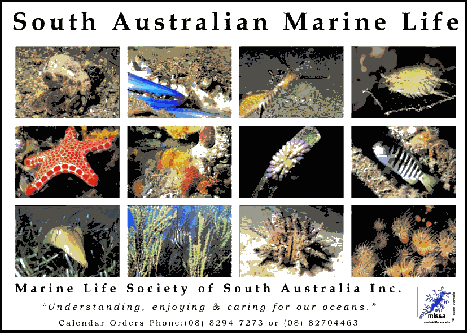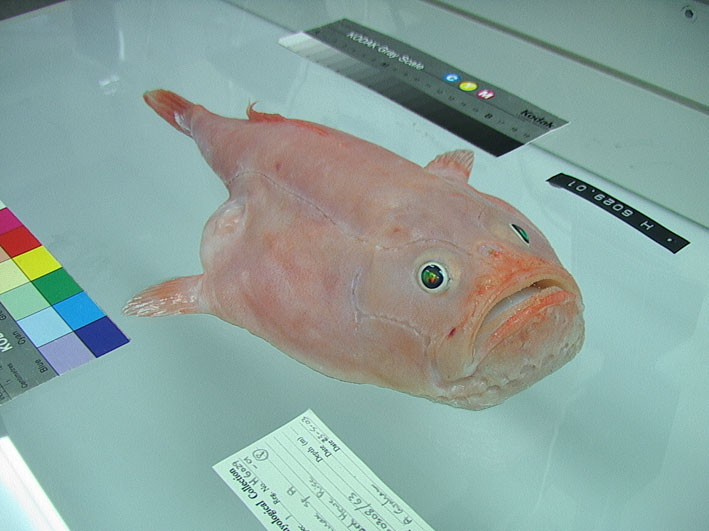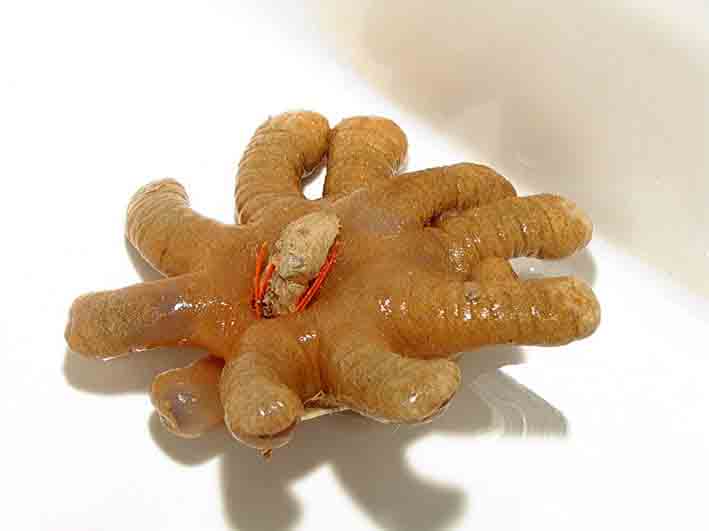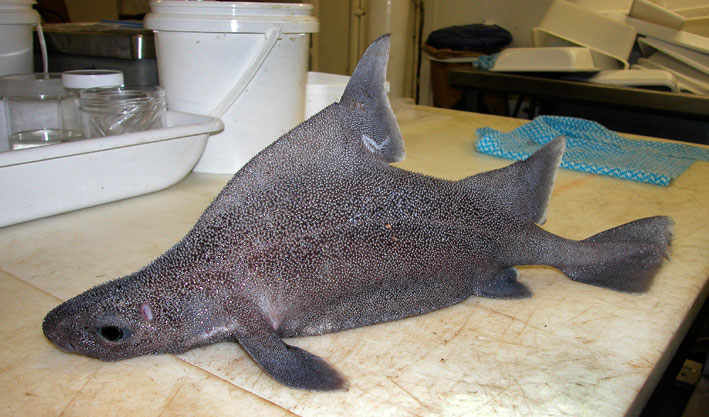
MLSSA
Newsletter
AUGUST 2003
No. 302
Next Meeting
Our meeting will be held at the Conservation Centre, 120 Wakefield Street, Adelaide on Wednesday 20th August commencing at 7.30pm.
Our speaker will be Dr Sean D. Connell from the University of Adelaide whose topic will be "Research into Southern Australia’s marine life".
(Dr Connell was unable to speak at our June meeting due to illness.)
This promises to be a very interesting talk and I hope everyone will arrive by 7.30pm so the speaker will be able to begin on time.
Contents
2004 Calendar
Golden Brown – The Unsung South
Maritime Museum Encounter Exhibition
The NORFANZ Voyage
Diving in Ireland The Forty Foot
Dive At Second Valley
Contributors
This month our authors are David Muirhead, Steve Reynolds, Alex Gaut and Chris Hall.
JOTS
Jonathan Shankar-Noble kindly supplied us with extra copies of the CD ROM "Coast and Marine Education Framework" which include a dozen pictures from the 2003 MLSSA Calendar.
These have now been given to the Nature Education Centre at Norwood for inclusion in the JOTS Kits.
The 7 kits were fully booked for every week of Term 1.
2004 Calendar
The MLSSA Calendar for 2004 has been printed and is available for sale.
We ask all members to take a minimum of 30 copies to sell.
You can get them at General Meetings or they can be delivered if necessary.
They are priced the same as last year:
$10 Aus. to non-members and $8 Aus. to members.
If you can let Philip Hall know of any possible sales outlets then please phone on either 0407395566 or 82704463.
The picture below shows the rear cover and the main photographs used in this calendar. The front cover is featured on Page 1 of the website.

Golden Brown – The Unsung South
Some have used the term ‘The Unique South’ to describe Southern Australia’s remarkable and very accessible biodiversity. As the title of my talk suggests, I prefer ‘The Unsung South’ – but fortunately for you my audience, I’m here not to sing, but to talk about my passion.
I ask you to indulge me briefly when I now half-quote, half-plagiarise, but above all admire C.S Lewis in his colourful and evocative descriptions of marine algae in ‘Perelandra’ (his was an imaginary world, but his prose is hard to better in describing South Australia’s marine macro-algae)
… Dissolving away, giving place to an indescribable confusion of colour – a rich, varied world in which nothing, for the moment, seemed palpable.
The sky was pure, flat gold like the background of a medieval picture.
The ocean was gold, too, flecked with innumerable shadows.
The nearer waves, though golden where their summits caught the light, were green on their slopes: first emerald, and lower down a lustrous bottle green, deepening to blue where they passed beneath the shadow of other waves.
The water gleamed, the sky burned with gold, but all was rich and dim, and his eyes fed upon it undazzled and unaching.
The very names green and gold are too harsh for the tenderness, the muted iridescence of that warm, maternal, deliciously gorgeous world.
It was mild to look upon as evening, warm like summer noon, gentle, and altogether pleasurable.
* * *
From the reefs’ tawny surface a whole series of feathery and billowy shapes arose, very unequal in height; they looked darkish against the dim glow of the golden reef.
Then they all tilted one way as the wave curled over above, and dipped out of sight.
Rocks trailed dark red skirts of tubes and strings and bladders over the surrounding blue-white sand…
Suspended weightless above the seaweed he gazed at the golden reef, and could hear the endless soothing noise of the water, and the muted burble of his air supply… like the primordial ebb and flow, life’s inner tide, timeless and seductive…
Enough, enough!!
In case you haven’t guessed; I’m crazy about our algae!
David Muirhead
We wish to acknowledge that C. S. Lewis is the main source of prose and sole source of inspiration (if one can call it that!) for this article. If we have inadvertently infringed upon someone’s copyright then we apologise and if necessary will remove the item from our website upon receipt of a written request by the copyright holder.
Maritime Museum Encounter Exhibition
In our February 2002 Newsletter (No.285) I wrote about specimens provided by our Society for a touring exhibition for the SA Maritime Museum. The exhibition concerned the Nicolas Baudin voyage 200 years ago. It was touring regional SA as part of the Encounter 2002 celebrations last year. Encounter 2002 was South Australia’s celebration of the bicentenary of the charting of the SA coast by Matthew Flinders and Nicolas Baudin. With the help of the Marine Invertebrate section of the SA Museum, we were able to provide the Maritime Museum with six species. These were to be set in resin. The exhibition is now on permanent display at the museum in Lipson Street at Port Adelaide. It is actually a combined Flinders and Baudin exhibition. It may, in fact, have been a combined exhibition that toured regional SA under the title "The Encounter: Flinders and Baudin". It opened in Ceduna in February 2002 and visited Port Lincoln, Whyalla, Port Augusta, Port Pirie, Port Victoria, Kingscote, Victor Harbor and Robe. I was able to visit the permanent exhibition at the Maritime Museum on 18th March. The specimens do not appear to be set in resin. There were three separate displays showing some of the specimens provided. One of the displays just featured the Red Sea-Toad (Spider Crab), Schizophrys rufescens. Another display featured just Gastropod shells. These were the three Pheasant Shells, Phasianella australis, and the Black Cowry, Cypraea (Zoila) freindii thersites. A third display featured the two sponge species. I don’t know at this stage what became of the two starfish species that we provided. Each individual display credited the Marine Life Society. I also saw a display recognizing sponsors for the exhibition and that credited the Society as being one of the sponsors.
Steve Reynolds
From 10th May – 8th June, 24 scientist from more than 11 research organisations (including CSIRO Hobart, Museum Victoria, the University of Tasmania, Australian Museum, Queensland Museum, Northern Territory Museum and NSW Fisheries) in Australia, New Zealand, France and America explored deep sea habitats around seamounts and abyssal plains around Lord Howe and Norfolk Islands through to northern New Zealand. This amazing research cruise collected biodiversity samples, DNA tissue samples, seabed habitat data, photographs and video on seamounts at depths between 200 metres and 1.2 kilometres, and surveyed free-swimming animals that live in the water masses above and around these seamounts.
The main objective of this expedition was to provide baseline information on the, nature and potential vulnerability of these unique habitats and their biodiversity. The results will give us a much better understanding of the species that live on and around the deep seamounts and ridges throughout the Tasman Sea, many of which may be new to science. The information will also enhance and contribute to international collaboration in oceans management.
The results of the expedition have been published via a daily diary accessible through the National Ocean’s Office website: http://www.oceans.gov.au/norfanz/ and I urge you to look it up even if it’s just for the pictures of the weird and wonderful creatures like this coffinfish!

Information from the website:
Coffinfishes are flabby bottom-dwelling fishes that occur in deep waters around the world. They can walk along the seafloor on short leg-like fins. These fish often come up in the nets swollen into a ball. Like the pufferfishes, they can swallow large amounts of water to inflate themselves, presumably making it harder for predators to bite into them. The lateral line system (a series of sensory pores that can detect vibrations and chemicals) is very obvious on their smooth bodies. Coffinfishes have a small lure on their head (like their anglerfish relatives), consisting of a short rod and a small glowing bulb at the tip used to lure its prey. The eyes of the fresh fish are speckled with iridescent green looking like a pair of spectacular opals. Our animals are around 20-30 cm long.
What about this very unusual arrangement for a hermit crab?

Information on the website:
These two deep-sea animals have come to a very agreeable arrangement. Hermit crabs have long soft bodies that must be protected. So they like to live safe inside other objects, typically shells. As shells can be rare in the deep sea, these hermit crabs have worked out a way to live inside a relative of anemones and corals known as "zonathid". Most corals and anemones need a hard surface on which to settle and grow. Most of the deep sea is mud and sand, so hard surfaces are rare. By these two animals getting together, they both benefit. The crab has a safe home in the tough leathery body of the zonathid, it may even be protected by the coral’s stinging tentacles. In return the coral gets carried to new places that might have more food, including the sorts of foods that the hermit crab scavenges. It is not known how this union starts but it’s possible that the two get together from a small size and grow up helping each other out.
Other unusual creatures incude the ‘dumbo’ (or finned) octopus, collapsable urchins, chimaeras, rattails, spineback eels (not true eels), hatchetfish, deep sea stargazers, prickly shark (see below), tripod fish, giant sea spiders, lantern sharks (one new undescribed species recently recognised in Australia), goblin shrimp (7 new species and probably a new family!).
I recommend wholeheartedly that you go and check the website, especially the creature feature, it is full of pictures of these fascinating creatures! What a fabulous expedition and a whole host of new discoveries and some very rare ones too.

Prickly Shark
Alex Gaut
The Forty Foot
Diving in Ireland is not too different from diving in South Australia, the invertebrate life and underwater terrain are quite similar the only exception is the fish life and the colder water.
Dublin has about the same population as Adelaide and is a coastal city surrounded by hills (Dublin Mountains). It supports a number of dive clubs affiliated to the Irish Underwater Council (CFT) all of which would use a number of different dive sites around Dublin. Some of the better dive sites are Ireland’s Eye, Muglins Rock, Dalkey Island and the Forty Foot, so named because at high tide it is about forty foot deep.
However the most unusual thing about diving the Forty Foot is not the fish life but the wildlife. It is designated a gentleman’s bathing place and is supposedly for exclusive use by men wishing to bathe in the sea. This attracts the most unusual wildlife imaginable- the over 60 naked male. Often seen parading around in all their naked glory, or should I say former glory, this species can be quite abrupt or rude especially to newly trained and unsuspecting female divers. There has been many verbal tirade uttered at divers from this pink, crinkled, pot bellied and balding species as to the sanctity of the Forty Foot their natural habitat. Anyway despite this unusual creature that inhabits the Forty Foot it is a very good shore dive and probably the first dive site for all newly trained divers in Dublin, me being the exception. I do however remember my first two sea snorkels, which were at the Forty Foot or rather at Sandycove Harbour just around the corner from the Forty Foot.
"This attracts the most unusual wildlife imaginable- the over 60 naked male."
It was March and for those that have lived in northern climes will know what the weather is like at that time of year- Bloody cold!! Well having finished pool training we had to log a number of sea snorkels before we could dive. All enthusiastic we rocked up to Sandycove and struggled into our new and extremely tight wetsuits, kitted up with ABLJ, for those to young to remember what an ABLJ is or was the old horse collar lifejacket, and full weight belt. The intention was to snorkel around from the Forty Foot to Sandycove Harbour but the sea state was atrocious, a one to two metre swell, zero visibility and 9 °C, so we opted to go in at the harbour. I only had full foot fins and after about 5 mins in the sea my feet were like iceblocks. After 10 mins I was thinking of the Great Barrier Reef and what was I doing in this freezing muck. 15 mins after entering the water and extreme torture it was time to return to terra firma. I was the first out of my wetsuit and into my nearly new ski jacket and by the time al our gear was packed some warmth had started to return to my body. I now knew what hypothermia was, no need to attend that lecture. Once the feeling had returned to our bodies we adjourned to a nearby pub for a few pints of the blackstuff. By then just enough feeling had returned to my fingers to hold the liquid gold.
"I had just stripped off and was in my bathers when it happened-SNOW, here I was nearly naked standing outside and it was snowing."
Next Sunday we found ourselves back at Sandycove to snorkel the Forty Foot a second time. Today was a better day weatherwise; the sea was calmer and greener looking, however it was still cold. After a quick brief we dispersed to kit up. While we were returning to our cars the temperature seemed to drop and it got darker. I had just stripped off and was in my bathers when it happened-SNOW, here I was nearly naked standing outside and it was snowing. My thoughts quickly turned to sunny OZ and what was this idiot doing standing in the SNOW almost naked. There was no shelter available so there I stood struggling to get into my wetsuit before I turned into a snowman. Fortunately it was only light SNOW shower but it lasted until we were kitted up. We then assembled at the Forty Foot for a quick snorkel brief and entered the water. It was freezing, about 6 °C. It must have been the water temperature that had kept the unusual wildlife away, probably afraid it might have frozen off their appendages. Even though it was so cold I was feeling a bit warmer as I had bootees and openfoot fins, certainly my feet felt warmer. The visibility was much better this week as you could see your hand in front of your mask. We snorkelled around the point then into Sandycove Harbour and onto the beach. We were all about to head for our cars when our sadist of an instructor had us assemble for a debrief. OK for him he was nice and warm in his drysuit. We stood around for a few minutes shivering to death while he raved on about something fairly inconsequential and taking great delight in our misery. When he had finished it was back to our cars and into some welcome warm clothes. Once we were dressed and ready it was off to the pub for few well-earned jars. There were another three snorkels to complete before we could dive but they were uneventful and thank the good Lord the weather did improve.
Next episode: actually diving the Forty Foot.
Chris Hall
On 23rd March 2003 I made my annual dive pilgrimage to Second Valley. My previous dive there had been on 16th January 2002 and the one before that had been on 21st January 2001. Those two dives were done with my buddy Peter but this was to be a Marine Life Society dive. Philip and Margaret were already there when Peter and I arrived at Second Valley. There were already some other divers there, but none from MLSSA. More Society divers soon joined us though. After a quick chat we started to gear up for our dive. There were to be a total of eight divers but we all went diving in different directions. Peter and I headed south to the caves area. Chris, Maggie, Tim, David and Jenny all headed for Lassiter’s Reef out from the beach. Phill did a solo dive around the jetty area. It was his first dive for some four years. Jenny has apparently returned to diving after some twenty years. Welcome back Phill and Jenny. Peter and I headed straight for the first ‘cave’ where we had started our previous two dives at Second Valley. After inspecting the ‘cave’ we wandered away from the cliffs to explore rocky outcrops and reefs to the south. Peter pointed out a young Blue Devil to me. We admired it for a moment before continuing on. We sighted a ‘cleaning station’ situation where weed whiting (species unknown, possibly Sharp-nosed or Pencil Weed Whiting) were busy cleaning large fish such as leatherjackets. Fish that we sighted as we explored the area included Silver Spots, a ray, Herring Cale of both sexes, Rainbowfish (ditto), Senator Fish and a juvenile Blue Groper. We followed a large cuttle for a short distance. Having reached our turn-back point we headed back north and towards the cliffs on the shore. We found ourselves in a real cave. It was deep and dark, with a hole in its roof. My torch found a large Blue Devil and a Roughy closeto the roof. Then I found a small cuttle as we were leaving the cave. During our swim back I caught a small Moonlighter, a large Ringed Toadfish and a starfish (very appropriately) for the Star of the Sea School aquariums. We reached our entry point (the southern bay) from where we swam around the point and on to the jetty. We handed our catch over to the jetty crew before swimming on to the beach since the jetty steps were out ofthe water. Phill McPeake was busy collecting specimens from around the jetty. I believe that he caught a couple of tiny cuttles (or dumpling squid), some clingfish and a moonlighter. He also caught a few other small fish and invertebrates and collected some caulerpa species of alga (yet he was some four years out of practice!). On our way to our exit at the beach we saw a juvenile flathead harassing small fish plus a few young squid. I don’t really know how the other divers went on Lassiter’s Reef other than that David’s strobe got flooded with saltwater, thus spoiling his dive with Jenny. I think that they were the last two divers out of the water though (from our group). I missed all of the action on the jetty but back at the car park there was much interest in the bucket full of specimens. The squid turned the water black with their ink discharge and had to be transferred into some clean water. We all discussed our dives with each other, changed back into our dry clothes and enjoyed lunch. Greg Perry from Dolphin Dive was there with friends and Geoff and Di Benn from Adventure Dive Centre were there with a few students. We had more chats before having to make the trip back home.
Steve Reynolds
2002 - NO JOURNAL because:
We did not have enough articles
Can
you help for the 2003 Journal?Articles of any length can be used. Any that are not suitable for the Journal may be used in future Newsletters.
You may know of others who can assist - please ask them to contact me - Philip Hall.